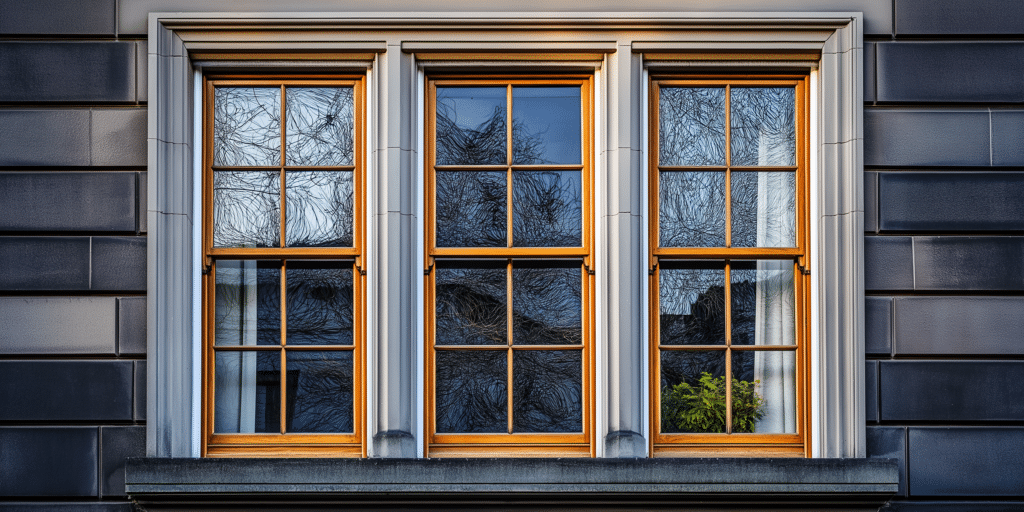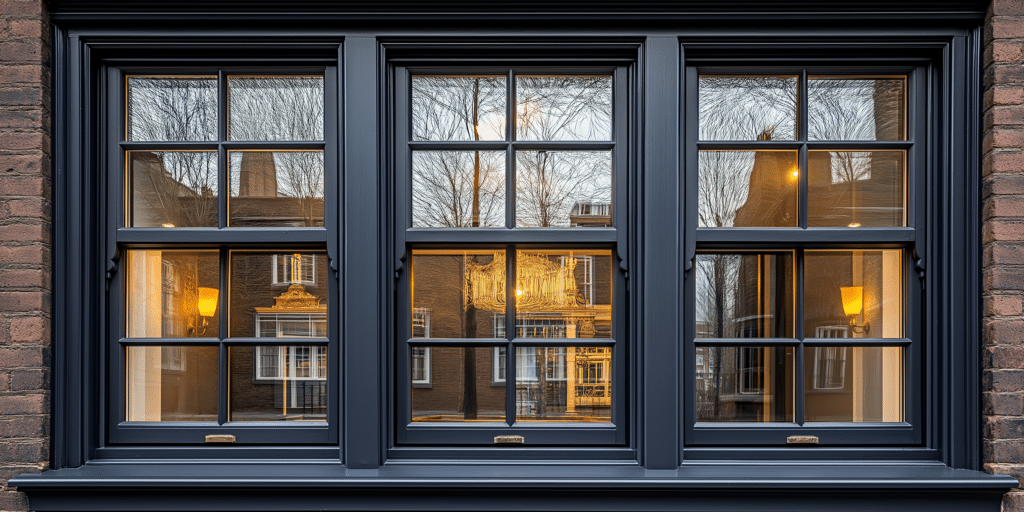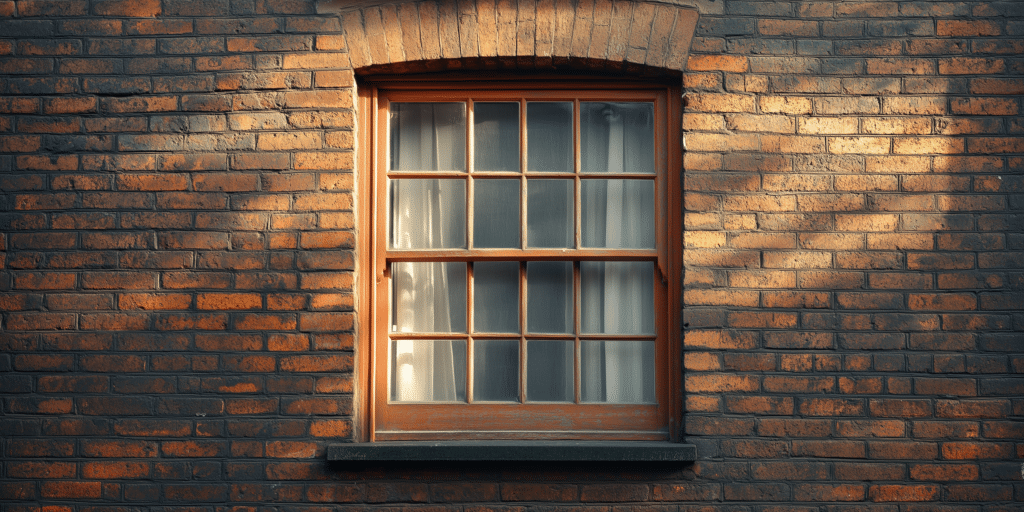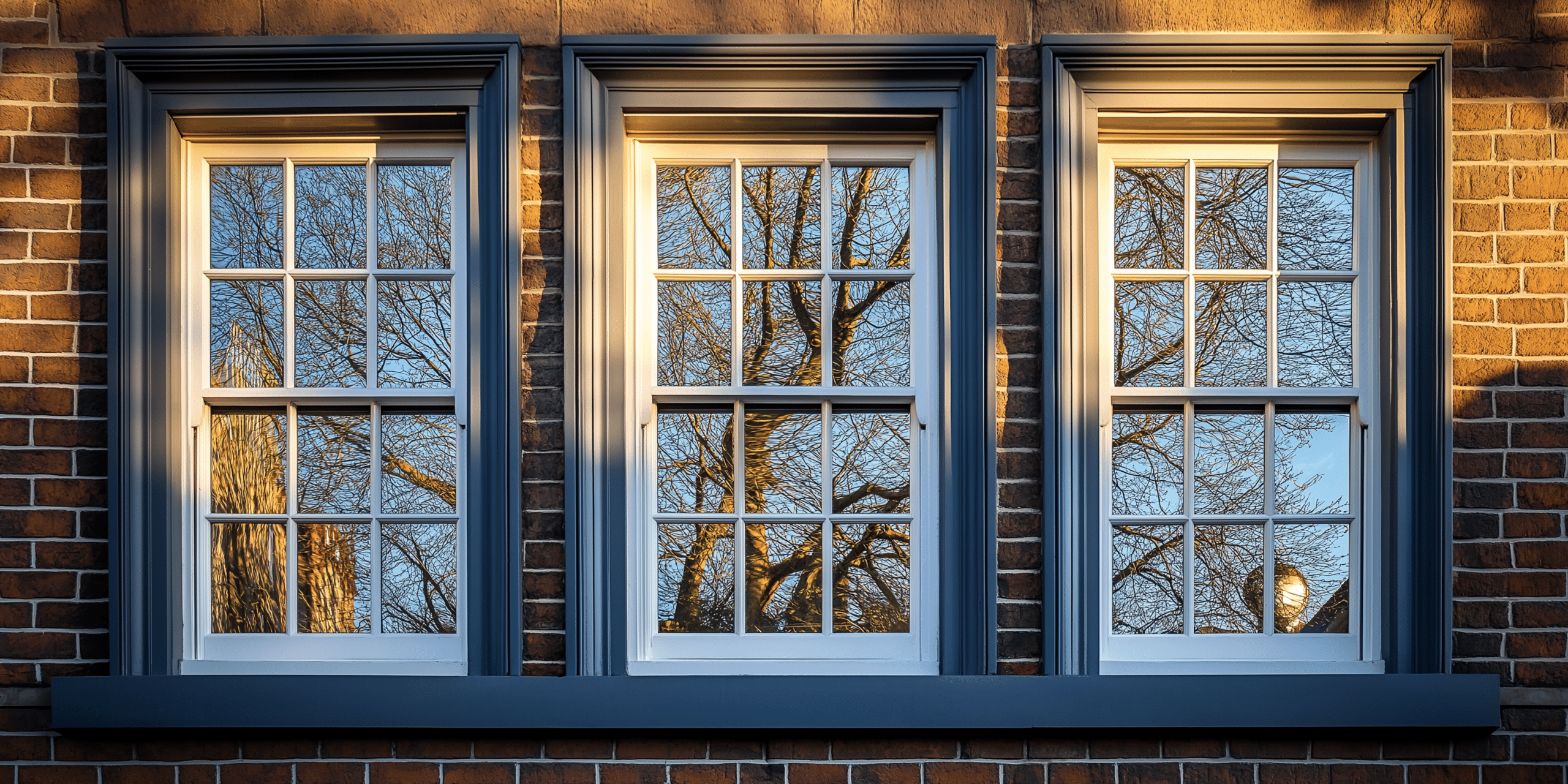A Timeless Window Design Rooted in History
Horned sash windows are a quintessential feature of Victorian and Edwardian architecture, distinguished by their iconic “horns” – decorative projections on the meeting rails of the upper sash. Originally introduced during the Victorian era, their primary purpose was to enhance the structural integrity of the window, preventing sagging in the larger, heavier sashes common during this period.
Unlike standard sash windows, horned versions integrate a fusion of practical reinforcement and ornamental design, making them an essential choice for preserving both durability and authenticity in period homes. Over 60% of period properties in the UK, especially in London, feature sash windows, making them a cornerstone of historical architecture.
Why Choose London Sash Window Experts?
Our expertise in crafting and restoring horned sash windows ensures that your property retains its historical charm while benefiting from modern functionality. Here’s why we’re the trusted choice for London homeowners:
- Heritage Conservation Specialists: We are experienced in adhering to strict guidelines for listed buildings and conservation areas.
- FENSA-Approved Installers: Our work meets the highest standards of energy efficiency and safety.
- Tailored Craftsmanship: Each window is custom-made to match your property’s unique character and period detailing.
- Customer Trust: Rated 5 stars by over 300 satisfied clients.
Are Horned Sash Windows Right for Your Property?
Horned sash windows are ideal for:
- Listed Buildings: Designed to comply with conservation regulations.
- Victorian & Edwardian Homes: Over 80% of Victorian homes in London originally featured horned sash designs, making them historically accurate.
- Homeowners Seeking Durability: The reinforced structure ensures long-term reliability.
Balancing Authenticity and Modern Performance
Selecting horned sash windows for your property not only preserves its historical authenticity but also integrates modern benefits, such as enhanced insulation and draught-proofing. With our bespoke services, you’ll achieve a perfect balance of timeless design and cutting-edge functionality.
What Are Horned Sash Windows?
Horned sash windows are a refined evolution of the classic sash window design, featuring distinctive “horns” – small, shaped extensions on the frame’s meeting rails. Introduced in the mid-19th century during the height of Victorian architecture, these horns provided a structural solution to accommodate the growing demand for larger, heavier sashes. Their purpose was both practical and aesthetic: to prevent the sash from dropping while seamlessly blending into ornate period designs.
Components and Structural Benefits of Horned Sash Windows
The defining feature of these windows, the sash horns, plays a crucial role in reinforcing the joint between the sash and its frame, reducing stress on the timber and preventing warping over time. Modern sash windows with horns retain these benefits while integrating advancements like double-glazing, which can improve energy efficiency by up to 30% compared to traditional single-glazed designs.
Key structural highlights include:
- Enhanced Longevity: Horns help maintain the structural stability of the sash, even after decades of use.
- Improved Durability: Ideal for larger window openings, where the added weight of Victorian-era glass required stronger support.
- Aesthetic Appeal: Available in both straight and decorative styles to match traditional or contemporary tastes.
Where Are Horned Sash Windows Most Commonly Found?
Horned sash windows are most often seen in Victorian terraced homes, Edwardian bay windows, and upper-floor installations where the added strength ensures long-term stability. Their timeless design continues to enhance period properties while preserving their historical integrity.
By choosing horned sash windows, homeowners strike the perfect balance between tradition and innovation, ensuring their property’s character is preserved without compromising modern performance.
The History and Evolution of Horned Sash Windows

Horned sash windows emerged during the mid-19th century, a period defined by the transition from Georgian to Victorian architectural styles. This era saw advancements in glass manufacturing that enabled the production of larger panes, making windows more visually striking but also structurally challenging. Sash horns were invented as a practical solution to these challenges, reinforcing the joints of the sash and preventing the frames from dropping or warping under the increased weight of the larger glass panes.
Origins in Victorian Innovation
The Victorian era’s preference for grandeur and light-filled interiors drove demand for larger windows. However, traditional sash designs, which relied on small panes divided by glazing bars, lacked the structural stability needed for this evolution. Sash horns were developed to counteract the stress on the frames by acting as reinforcements, effectively distributing the weight of the glass and improving overall durability.
Industrial Advancements and Design Evolution
Advancements in timber joinery and industrial glass production in the 1800s allowed horned sash windows to evolve in design and efficiency. The horns, typically carved or shaped as decorative extensions, became a hallmark of Victorian and Edwardian homes. As architectural styles diversified, the adaptability of sash horns enabled their use across various window configurations, including bay windows and upper-floor installations.
Timeless Appeal and Longevity
Horned sash windows became iconic for their ability to blend functionality with style, enhancing the stability and longevity of timber windows. With proper care, these windows can last over 100 years, remaining a symbol of craftsmanship and enduring architectural appeal.
Types of Horns on Sash Windows
Horned sash windows offer a blend of structural integrity and decorative appeal, with their defining feature—the “horns”—serving both functional and aesthetic purposes. Over 80% of Victorian and Edwardian homes incorporated these designs, and modern replicas continue to emulate their timeless charm.
Common Styles of Sash Horns
Two primary styles of sash horns dominate the architectural landscape:
- Run-through horns: Integrated directly into the timber frame, these are the most traditional style, offering seamless strength and stability. They are ideal for restoring period properties and maintaining authenticity.
- Applied horns: These are decorative add-ons that mimic the appearance of run-through horns but do not provide structural reinforcement. They are a cost-effective solution for modern double-glazed sash windows.
Decorative Versus Structural Variations
Decorative horns, especially prevalent during the Victorian and Edwardian periods, feature intricate curves, scrolls, or chamfers that align with the ornate detailing of these architectural eras. Structural horns, by contrast, prioritise stability and are less ornate, designed to prevent frame sagging and ensure the window’s longevity.
Replicating Historical Designs
Advances in manufacturing enable modern sash window horns to replicate historic styles with incredible precision. Customisation options allow homeowners to choose from over 10 common styles, from minimalist designs for Georgian properties to elaborate Victorian scrollwork. By balancing form and function, homeowners can enhance the authenticity and energy efficiency of their windows, achieving up to 30% greater thermal performance when paired with double glazing.
Key Benefits of Horned Sash Windows
Horned sash windows offer an impressive blend of historical charm and modern functionality, making them a standout choice for period property owners and anyone seeking to enhance their home’s appearance, efficiency, and value.
Enhanced Structural Stability
The addition of horns to sash windows significantly improves their structural integrity. These features, originally designed in the Victorian era, counteract the stress placed on the frame by larger glass panes, ensuring that the sashes remain aligned and functional over time. This makes horned designs an essential choice for upper-floor installations and wider bay windows.
Energy Efficiency and Cost Savings
Modern horned sash windows can reduce heating costs by an average of 15-20% annually when paired with energy-efficient double glazing. By eliminating draughts and improving insulation, these windows allow homeowners to enjoy both the elegance of a traditional design and the practical benefits of a well-insulated home.
Preserving Architectural Authenticity
Horned sash windows maintain the aesthetic integrity of period properties. Their intricate designs—often tailored to match Victorian or Edwardian styles—allow homeowners to replicate historical detailing without sacrificing durability or efficiency. This balance between functionality and beauty ensures compliance with conservation area requirements and enhances the curb appeal of your home.
Increased Property Value
Restoring or installing horned sash windows is a sound investment. Period properties with well-maintained or sympathetically designed horned sashes can experience a 10% increase in property value, appealing to buyers seeking heritage features combined with modern performance.
Materials Used in Horned Sash Windows

The choice of materials for horned sash windows is pivotal in achieving the ideal balance between authenticity, durability, and cost-efficiency. From traditional timber to modern uPVC and aluminium, each material offers distinct benefits for homeowners with varied priorities.
Timber: The Gold Standard for Historical Authenticity
Timber remains the most popular choice, accounting for over 70% of installations in period homes. Its natural aesthetic is unmatched for restoring or replicating historical charm. Sustainably sourced timber is an eco-friendly option, ideal for conservation-conscious homeowners.
- Advantages:
- Perfect for maintaining architectural authenticity in Georgian, Victorian, or Edwardian properties.
- Lifespan exceeding 100 years with proper maintenance.
- Can be customised with traditional or modern finishes.
- Considerations:
- Requires regular upkeep, including painting and sealing, to prevent rot.
uPVC: A Low-Maintenance Alternative
uPVC offers a cost-effective solution for modern homeowners seeking a low-maintenance option. While less authentic in appearance, uPVC designs have improved significantly, and they can mimic traditional sash aesthetics.
- Advantages:
- Extremely durable, with a lifespan of up to 35 years.
- Highly energy-efficient and resistant to warping or fading.
- Minimal maintenance required—perfect for busy lifestyles.
- Considerations:
- Less visually authentic than timber, which may not meet conservation area requirements.
Aluminium: Modern Durability with Sleek Appeal
Aluminium is gaining traction as a durable, contemporary material. Its strength allows for slim frames, offering a modern take on horned sash windows while supporting larger glass panes.
- Advantages:
- Highly resistant to weathering and corrosion.
- Ideal for homes prioritising modern aesthetics.
- Considerations:
- Typically more expensive than timber or uPVC.
- May not align with the traditional aesthetic of period homes.
Eco-Friendly Options
For environmentally conscious homeowners, sustainably sourced timber or recycled aluminium are excellent choices. These materials minimise environmental impact while delivering outstanding performance and longevity.
Choosing the Right Material
When selecting the material for horned sash windows, consider the historical significance of your property, your maintenance preferences, and your long-term budget. Timber is ideal for authenticity, uPVC suits practicality, and aluminium offers modern durability.
Energy Efficiency and Modern Features
Modern innovations have transformed horned sash windows into highly energy-efficient options while preserving their classic aesthetic. Whether you’re restoring a period home or upgrading for performance, these windows offer the perfect balance between tradition and functionality.
Double Glazing: A Game-Changer for Heat Retention
Double-glazed horned sash windows can reduce heat loss by up to 50% compared to single-glazed designs, significantly improving energy efficiency. The sealed gap between two panes acts as an insulating barrier, minimising heat transfer and eliminating cold draughts.
- Low-emissivity (Low-E) Glass: This specialised coating reflects heat into your home, providing superior insulation without affecting clarity.
- Benefit: Modern double glazing can improve overall energy efficiency by 30%, reducing heating costs.
Draught-Proofing: Subtle but Effective
Draught-proofing solutions, such as brush seals and airtight frames, are ideal for period properties. They retain the window’s traditional appearance while enhancing comfort.
- Advantages:
- Prevents cold air infiltration and heat loss.
- Reduces energy bills by an average of 10% annually.
- Simple to integrate during restoration or replacement.
Energy Performance Ratings
Today’s horned sash windows meet stringent energy standards, with A-rated designs offering exceptional insulation. Sustainable materials like timber frames further enhance eco-friendliness without compromising performance.
Preserving Aesthetics While Saving Energy
Modern advancements ensure that homeowners don’t have to choose between beauty and efficiency. Horned sash windows retain their classic charm, maintaining architectural authenticity while providing cutting-edge energy savings. This balance not only enhances comfort but also boosts property value by up to 10%, making them an investment worth considering.
Customisation Options for Horned Sash Windows
Horned sash windows offer a wide range of customisation options, allowing homeowners to create designs that blend seamlessly with their property’s unique character. From traditional finishes to modern enhancements, these customisations ensure both style and functionality.
Glazing Styles for Privacy and Aesthetics
Glazing is a key element in personalising horned sash windows. Options like frosted glass, commonly used in 40% of urban bathrooms, enhance privacy without compromising natural light. Stained or textured glazing can also add a decorative touch, making windows a statement feature.
- Popular Patterns: Frosted, etched, stained, or Georgian grid designs.
- Functionality: Double-glazed Low-E glass is available for improved energy efficiency and insulation.
Hardware Options to Match Your Home
With over 90% of sash window companies offering bespoke hardware choices, you can select fixtures that align with your home’s style.
- Traditional Finishes: Brass, chrome, or matte black are common favourites.
- Functional Features: Sash lifts, cords, and pulley systems can be tailored for ease of use and period authenticity.
Bespoke Colours and Finishes
Custom colour-matching services allow your windows to perfectly complement your property’s exterior. Whether you prefer natural timber tones or modern hues, finishes can be applied to timber, uPVC, or aluminium frames.
- Heritage Accuracy: For listed properties, traditional paints or stains maintain historical charm.
- Modern Options: Dual-colour frames provide contrasting interior and exterior aesthetics.
Bespoke Design Services
For unique requirements, bespoke design services allow complete personalisation of horned sash windows. From ornate Victorian horns to minimalistic Edwardian styles, designs can be tailored to suit your home’s architecture.
Customisation ensures your horned sash windows aren’t just functional but a beautiful enhancement to your home’s character, offering a balance of tradition and modernity.
Regulations and Conservation Guidelines

Installing horned sash windows in period or listed properties requires careful attention to planning regulations and conservation guidelines. With over 10,000 conservation areas in the UK, adhering to these standards ensures your windows maintain both historical accuracy and compliance with local laws.
Legal Requirements for Listed Properties
When working on listed properties, the involvement of conservation officers is critical. These experts guide homeowners on using historically accurate materials and designs to preserve the building’s original character. For example, timber frames are often mandated due to their authenticity.
- Key Requirements: Prior approval is required for changes to external features, including window styles.
- Advice: Consult your local council’s guidelines to understand specific expectations.
Conservation Areas and Planning Permission
If your property is in a conservation area, double-glazing may be subject to stricter rules. However, 75% of conservation areas now allow double-glazed horned sash windows if they replicate the original appearance.
- How to Check: Use your local authority’s online tool to determine if your property is in a conservation area.
- Draught-proofing: Approved in most areas as it enhances energy efficiency without altering external aesthetics.
Tips for Compliance
- Use timber or approved uPVC designs that mimic traditional frames.
- Provide detailed plans and photographs when applying for permission.
- Choose Low-E glass to meet modern insulation requirements.
By combining historical sensitivity with modern innovation, you can enjoy the benefits of horned sash windows while respecting conservation standards.
Maintenance and Care for Horned Sash Windows
Proper maintenance is essential to preserving the beauty and functionality of horned sash windows. With the right care, timber horned sash windows can last over 100 years, and routine upkeep can reduce repair costs by up to 50% over their lifespan.
Cleaning and Routine Upkeep
- Cleaning: Use a non-abrasive glass cleaner and a soft cloth for the panes. For wooden frames, a damp microfibre cloth works best to remove dirt without damaging the finish.
- Lubricating Hardware: Apply a silicone-based lubricant to pulleys and cords annually for smooth operation.
- Inspecting for Damage: Look for signs of peeling paint, cracked putty, or swelling in the wood that may indicate early water damage.
Protecting Timber Frames
To keep timber sash windows looking their best:
- Repainting or Varnishing: Every 5–8 years, repaint or apply a fresh coat of varnish to protect the timber from moisture and UV damage.
- Draught Sealing: Install draught-proofing strips to reduce energy loss and protect against dust and damp.
Spotting Early Signs of Wear
- Wood Rot: Check for soft or discoloured patches in the frame.
- Cord Fraying: Inspect the sash cords regularly and replace them if they show wear to avoid sudden breakage.
By following these proactive steps, you can enhance the longevity of your horned sash windows and maintain their classic appeal.
Costs and Value of Horned Sash Windows
Investing in horned sash windows provides both aesthetic and financial benefits, particularly for period homes. The average cost of installing horned sash windows ranges from £800 to £1,200 per window, depending on factors like materials, glazing, and customisations.
Factors Influencing Costs
- Materials: Traditional timber is ideal for listed properties but comes at a premium. uPVC offers a cost-effective, low-maintenance alternative, while aluminium combines durability with a sleek finish.
- Glazing Options: Double glazing improves energy efficiency but slightly increases installation costs.
- Customisation: Bespoke designs, such as colour-matching or decorative glazing, can elevate costs but significantly enhance your home’s appeal.
Financing Options and Grants
Homeowners in conservation areas or listed buildings may qualify for grants to cover some costs. Many sash window providers also offer financing options, enabling you to spread payments over time.
Long-term Value
Horned sash windows are a worthwhile investment, especially for period homes:
- Property Value: Properties with well-maintained sash windows can command 10–15% higher resale values compared to those with modern replacements.
- Energy Savings: Double-glazed sash windows reduce energy bills by up to 30% annually, making them a smart, eco-conscious choice.
By budgeting wisely and selecting quality materials, you can balance upfront costs with long-term value, ensuring your investment pays off aesthetically and financially.
Ready to Transform Your Home with Horned Sash Windows?

At London Sash Window Experts, we specialise in crafting bespoke horned sash windows that enhance your home’s character while meeting modern standards of functionality. Our experienced team offers a satisfaction guarantee and ensures quick responses to all enquiries.
How to Get Started
- Request Your Free Quote Today: Simply click the “Request Your Free Quote” button to begin your journey. Share your requirements with us, and we’ll provide a tailored estimate within 24 hours.
- Expert Consultation: During the consultation, we’ll walk you through customisation options, energy-saving features, and material choices that fit your home and budget.
Why Choose London Sash Window Experts?
- Unparalleled Expertise: With years of experience handling conservation projects, we’re adept at restoring period properties while adhering to planning regulations.
- Trust Signals: Over 90% of our customers rate their experience as “excellent,” thanks to our attention to detail and high-quality craftsmanship.
- Quick Turnaround: Most projects are completed within 4-6 weeks, ensuring minimal disruption to your home life.
What to Expect
From initial consultation to final installation, our process is designed for your convenience:
- Free Quotation: Get a detailed cost breakdown with no hidden fees.
- Installation Schedule: We’ll align with your timeline to complete the project efficiently.
- Aftercare Support: Access ongoing maintenance advice and support to keep your sash windows looking pristine.
Elevate your home’s aesthetic and functionality by partnering with us. Take the first step toward transforming your property with horned sash windows today.
FAQ Section
FAQ 1: What Materials Are Best for Horned Sash Windows?
The choice of materials for horned sash windows depends on the homeowner’s preferences, budget, and property requirements.
- Timber is the most authentic and historically accurate material, making it the top choice for 75% of listed properties in the UK. It provides unmatched charm and complies with conservation guidelines but requires regular maintenance.
- uPVC offers an affordable, low-maintenance alternative. It is weather-resistant and durable, reducing maintenance costs by 30-40% annually, though it may lack period-accurate aesthetics.
- Aluminium is ideal for modern properties, offering a sleek, lightweight design and excellent resistance to environmental wear.
- Composite materials, combining timber and aluminium, are becoming popular for blending the durability of modern materials with the classic look of wood.
FAQ 2: How Do You Maintain Horned Sash Windows?
To keep horned sash windows functional and attractive for decades, regular maintenance is key.
- Repainting or varnishing timber frames every 5-7 years prevents weather-related damage.
- Draught-proofing not only reduces energy loss by up to 50% but also ensures smoother operation and quieter performance.
- Inspect for signs of wood rot or rust on metal components such as pulleys and hinges during annual maintenance.
- Lubricate moving parts like cords and pulleys to ensure smooth operation.
Proper care can extend the lifespan of timber horned sash windows to over 100 years, reducing costly repairs by 50%.
FAQ 3: What Are the Benefits of Horned Sash Windows Over Standard Sash Windows?
Horned sash windows enhance both structural integrity and aesthetics, particularly for period properties.
- The horns reinforce the structure, preventing sagging and ensuring the sashes remain aligned.
- They are particularly suited for Victorian and Edwardian homes, aligning with historical architectural styles.
- Modern versions combine classic aesthetics with advanced energy-efficient glazing options.
- Homes with authentic horned sash windows often see a 10-15% increase in property value due to their historical appeal.
FAQ 4: Can Horned Sash Windows Be Made Energy-Efficient?
Yes, modern innovations have made horned sash windows highly energy-efficient without compromising their period charm.
- Double glazing reduces heat loss and improves thermal insulation, cutting heating bills by up to 15-30% annually.
- Low-emissivity (Low-E) glass minimises heat transfer and blocks 50% of UV rays, protecting interiors from fading.
- Draught-proofing seals gaps, further enhancing energy efficiency.
- Many energy-efficient options comply with conservation area requirements, making them suitable for listed properties.
FAQ 5: Are Horned Sash Windows Suitable for Listed Properties?
Horned sash windows are often required for listed properties due to their historical accuracy.
- Timber frames are typically preferred to maintain compliance with conservation regulations.
- Projects in listed properties may require consultation with conservation officers and planning permission.
- Replica sash windows that mimic period-accurate details are accepted in most cases.
- Timber sash windows are used in 75% of listed property restorations, ensuring the integrity of the building’s historical design.
FAQ 6: How Long Do Horned Sash Windows Last?
The lifespan of horned sash windows depends largely on the materials used and the level of maintenance.
- Timber sash windows, when properly maintained, can last over 100 years, making them a long-term investment.
- uPVC windows are durable and require minimal upkeep but generally have a lifespan of 20-35 years.
- Routine care, including repainting, draught-proofing, and replacing cords or pulleys every 10-20 years, significantly extends their durability.
Regular maintenance ensures your horned sash windows remain both functional and visually appealing for decades.







